Executive Summary
Users on the internet rely on domain names to find brands, services, professionals and personal websites. Cybercriminals take advantage of the essential role that domain names play on the internet by registering names that appear related to existing domains or brands, with the intent of profiting from user mistakes. This is known as cybersquatting. The purpose of squatting domains is to confuse users into believing that the targeted brands (such as Netflix) own these domain names (such as netflix-payments[.]com) or to profit from users’ typing mistakes (such as whatsalpp[.]com for WhatsApp). While cybersquatting is not always malicious toward users, it is illegal in the U.S.,[1] and squatting domains are often used or repurposed for attacks.
The Palo Alto Networks squatting detector system discovered that 13,857 squatting domains were registered in December 2019, an average of 450 per day. We found that 2,595 (18.59%) squatted domain names are malicious, often distributing malware or conducting phishing attacks, and 5,104 (36.57%) squatting domains we studied present a high risk to users visiting them, meaning they have evidence of association with malicious URLs within the domain or are utilizing bulletproof hosting.
We also ranked the Top 20 most abused domains in December 2019 based on adjusted malicious rate, which means that a domain is either a target of many squatting domains or most of these squatting domains are confirmed malicious. We found that domain squatters prefer profitable targets, such as mainstream search engines and social media, financial, shopping and banking websites. When visiting these sites, users are often prepared to share sensitive information, which opens them up to phishing and scams to steal sensitive credentials or money if they can be deceived into visiting a squatting domain instead.
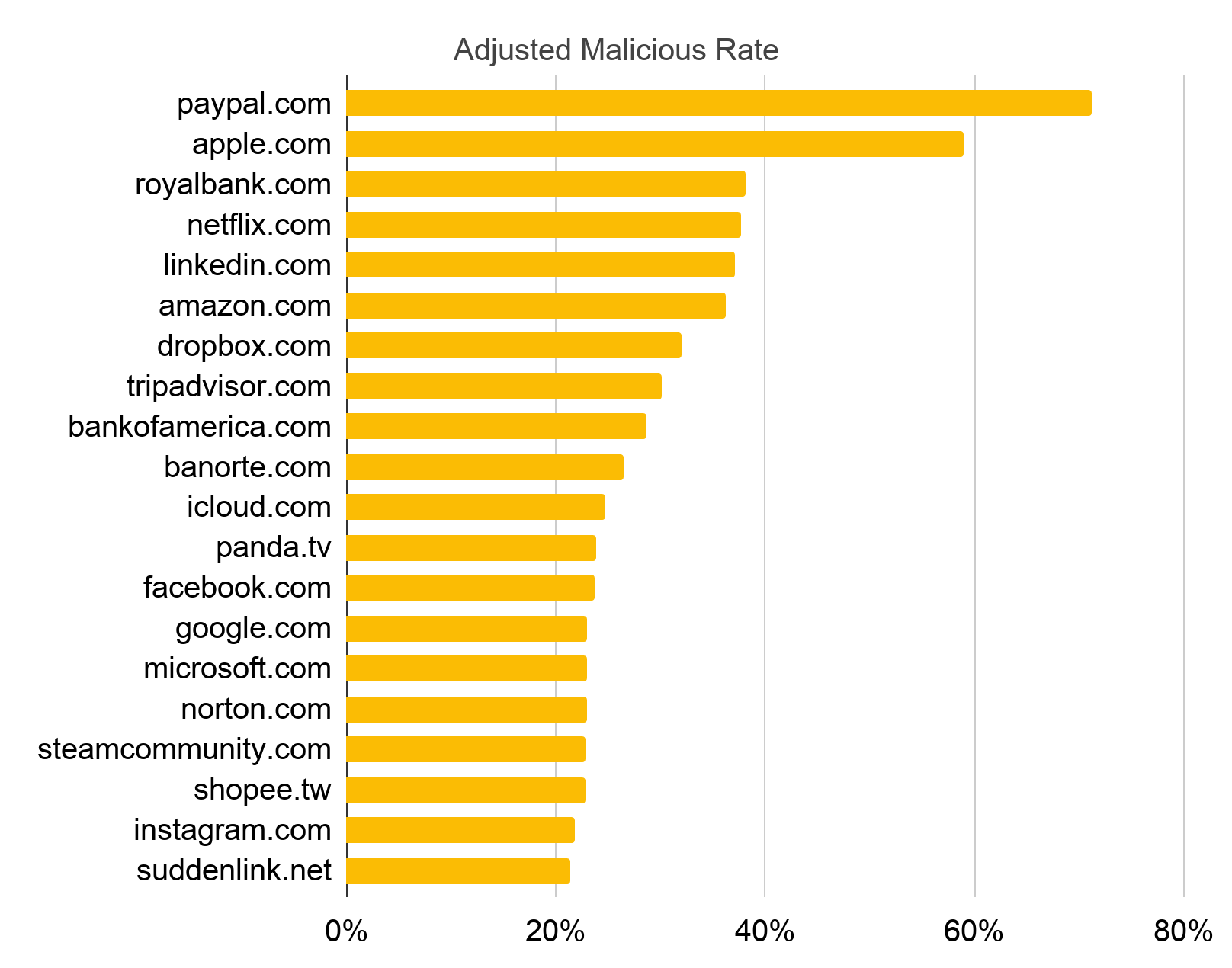
From December 2019 to date, we observed a variety of malicious domains with different objectives:
- Phishing: A domain mimicking Wells Fargo (secure-wellsfargo[.]org) targeting customers to steal sensitive information, including email credentials and ATM PINs. Also, a domain mimicking Amazon (amazon-india[.]online) set up to steal user credentials, specifically targeting mobile users in India.
- Malware distribution: A domain mimicking Samsung (samsungeblyaiphone[.]com) hosting Azorult malware to steal credit card information.
- Command and control (C2): Domains mimicking Microsoft (microsoft-store-drm-server[.]com and microsoft-sback-server[.]com) attempting to conduct C2 attacks to compromise an entire network.
- Re-bill scam: Several phishing sites mimicking Netflix (such as netflixbrazilcovid[.]com) set up to steal victims’ money by first offering a small initial payment for a subscription to a product like weight loss pills. However, if users don’t cancel the subscription after the promotion period, a much higher cost will be charged to their credit cards, usually $50-100.
- Potentially unwanted program (PUP): Domains mimicking Walmart (walrmart44[.]com) and Samsung (samsungpr0mo[.]online) distributing PUP, such as spyware, adware or a browser extension. They usually perform unwanted changes, like changing the browser's default page or hijacking the browser to insert ads. Of note, the Samsung domain looks like a legitimate Australia educational news website.
- Technical support scam: Domains mimicking Microsoft (such as microsoft-alert[.]club) trying to scare users into paying for fake customer support.
- Reward scam: A domain mimicking Facebook (facebookwinners2020[.]com) scamming users with rewards, such as free products or money. To claim the prize, users need to fill out a form with their personal information such as date of birth, phone number, occupation and income.
- Domain parking: A domain mimicking RBC Royal Bank (rbyroyalbank[.]com) leveraging a popular parking service, ParkingCrew, to generate profit based on how many users land on the site and click the advertisements.
We studied domain squatting techniques including typosquatting, combosquatting, level-squatting, bitsquatting and homograph-squatting (all defined below). Malicious actors can use these techniques to distribute malware or to conduct scams and phishing campaigns.
To detect squatting domains, Palo Alto Networks developed an automated system to capture emerging campaigns from newly registered domains, as well as from passive DNS (pDNS) data. We continue to detect currently active cybersquatting domains – we identify malicious and suspicious squatting domains and designate them to the appropriate categories (such as phishing, malware, C2 or grayware). Protections against domains classified in these categories are available in multiple Palo Alto Networks security subscriptions, including URL Filtering and DNS Security.
We recommend that enterprises block and closely monitor traffic from these domains, while consumers should make sure that they type domain names correctly and double-check that the domain owners are trusted before entering any site. More tips can be found in this post on how to protect against cyberattacks.
Squatting Techniques
Typosquatting is one of the most common types of domain registration abuse. Typosquatters intentionally register misspelled variants (such as whatsalpp[.]com) of target domain names (whatsapp[.]com) to profit from users’ typing mistakes or to deceive users into believing that they are visiting the correct target domain. The most frequent typosquatting techniques include registering names one edit distance from the original domain, as these are the most common and overlooked mistakes users make. For more information, readers can refer to academic research papers on the scale and malicious use of typosquatting.
Combosquatting is another widespread registration abuse that combines popular trademarks with words such as “security,” “payment” or “verification.” Combosquatting domains like netflix-payments[.]com are often used in phishing emails, by scam websites and for social engineering attacks to convince users that they are visiting web content maintained by the targeted trademark. For more information, readers can refer to this academic paper on a longitudinal study of combosquatting.
Homographsquatting domains take advantage of internationalized domain names (IDNs), where Unicode characters are allowed (such as microsofŧ[.]com). Attackers usually replace one or more characters in the target domain with visually similar characters from another language. These domains can be perfectly indistinguishable from their targets, as in the case of apple.com, where the English letter "a" (U+0061) was replaced with the Cyrillic letter "а" (U+0430). For more information, readers can refer to academic research papers on IDNs.
Soundsquatting domains take advantage of homophones, i.e., words that sound alike (for example, weather and whether). Attackers can register homophone variants of popular domains, such as 4ever21[.]com for forever21[.]com. As text-to-speech software like Siri and Google Assistant becomes prevalent, more and more users will become vulnerable to the abuse of soundsquatting domains. For more information, readers can refer to this academic research paper on soundsquatting.
Bitsquatting domains have a character that differs in one bit (such as micposoft[.]com) from the same character as the targeted legitimate domain (microsoft[.]com). Bitsquatting can benefit attackers because a hardware error can cause a random bit-flip in memory where domain names are stored temporarily. Thus, even though users type the correct domains, they may still be led to malicious ones. Although such hardware errors are usually rare, an academic research paper has shown that bitsquatting is a real threat.
Levelsquatting domains, such as the case of safety.microsoft.com.mdmfmztwjj.l6kan7uf04p102xmpq[.]bid, include the targeted brand’s domain name as a subdomain. In this example, the victims of the phishing attack might believe they are visiting safety.microsoft.com, when instead, they are visiting the attacker’s website. This attack is especially worrisome for mobile users because the browser's address bar might not be wide enough to display the entire domain name. For more information, readers can refer to this academic paper for a more comprehensive study of levelsquatting domains.
Detection of Various Squatting Techniques
We leverage lexical analysis to detect candidate squatting domains among the Palo Alto Networks newly registered domain (NRD) and pDNS feeds. Our list of target domains is the combination of popular domains in general and domains popular in specific categories, such as shopping and business. We generate the aforementioned squatting variants of the target domains, and match them against our NRD feed and pDNS hostnames. Additionally, we cluster weekly collections of NRDs to see if registration campaigns target known brands. After the initial discovery step, we leverage WHOIS data to filter out defensive registrations and a heuristic rule-based classifier to identify which domains are true squatting domains.
Figure 1 shows the daily detection statistics for December 2019. During this period, we detected 13,857 squatting domains (~450 per day). Since then, the number of daily detections fluctuate from 200-900. To understand how these domains are leveraged for abuse, we use URL Filtering to categorize them. We label domain names as malicious if they are involved in distributing malware or phishing, or if they are being used for command and control (C2) communication. We label domains categorized as grayware, parked, questionable, insufficient content and high-risk as suspicious. The average malicious rate of the 13,857 squatting domains is 18.59% (2,595) and the average suspicious rate is 36.57% (5,104).
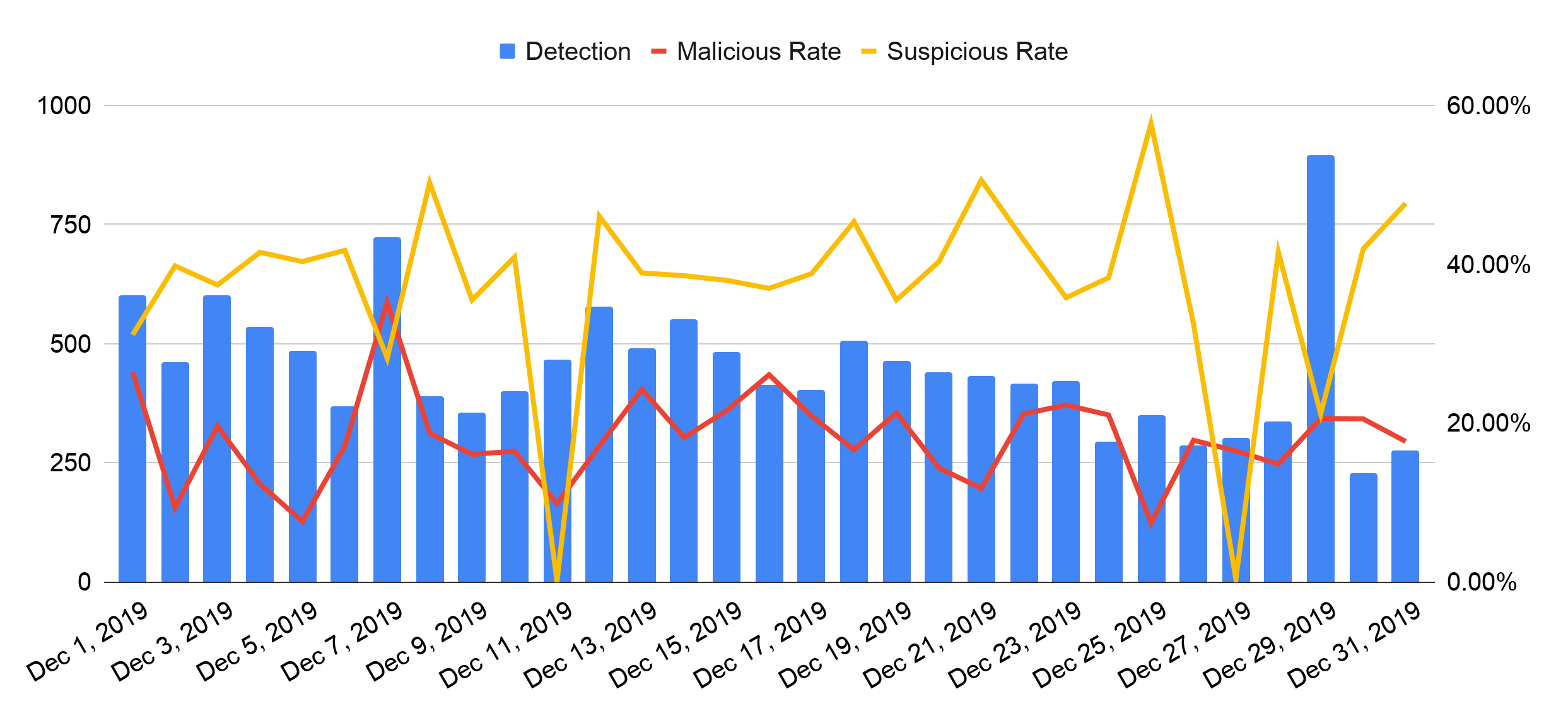
Next, we compare our detection of squatting domains to vendors found on VirusTotal. Considering detection delays, we allow a 10-day time window for malicious squatting domains to appear on VirusTotal. Figure 2 shows how well the top 10 vendors detected these malicious and high-risk domains. The best-performing vendor covers about 25% of the malicious or high-risk squatting domains that we detected. Meanwhile, other vendors cover less than 20% of our detections. Lastly, we found that 55% of malicious or high-risk squatting domains are not detected by any vendors.
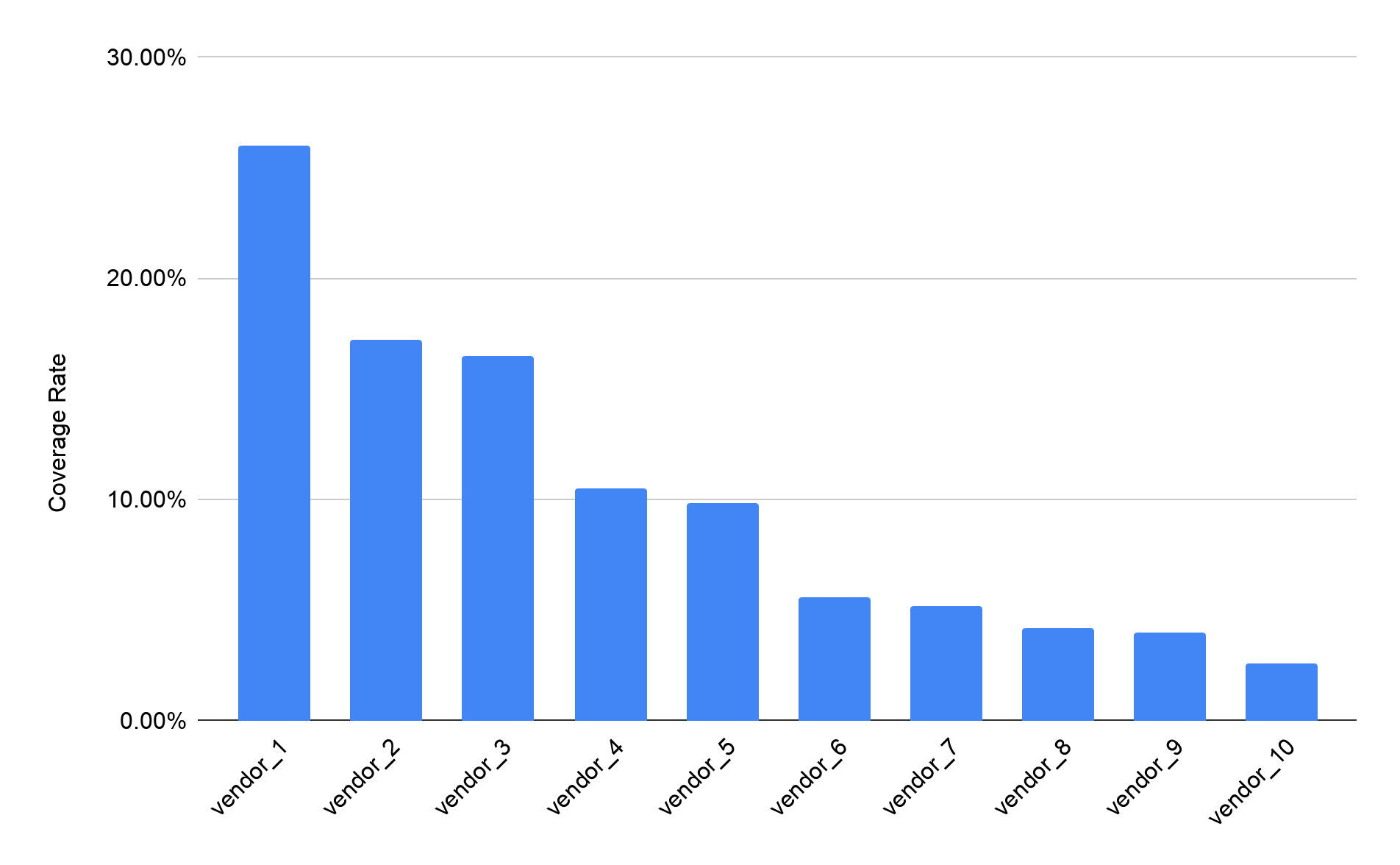
The Domain Squatting Ecosystem
To identify malicious infrastructure hotspots, we studied specific network elements and entities that typosquatters depend on for their operations. Specifically, we studied popular registrars, name services, autonomous systems and certificate authorities used by domain squatters.
For each chart outlined below, we considered the number of squatting detections to reflect their popularity among domain squatters, and the malicious IOC rate to quantify the degree of threat to users. Combining these two metrics, we calculated the adjusted malicious rate of each entity. Thus, a high adjusted malicious rate means that an entity is either targeted by many squatting domains or most of these squatting domains are malicious.
Top 20 Most Abused Domains
Domain squatters prefer popular and thus profitable targets. Figure 3 shows the Top 20 most abused domains. These targets are popular websites, such as mainstream search engines and social media, financial, shopping and banking websites. Squatting domains mimicking these websites benefit from their credibility to attract more users that can be scammed. Therefore, these targets have relatively high squatting detection numbers.
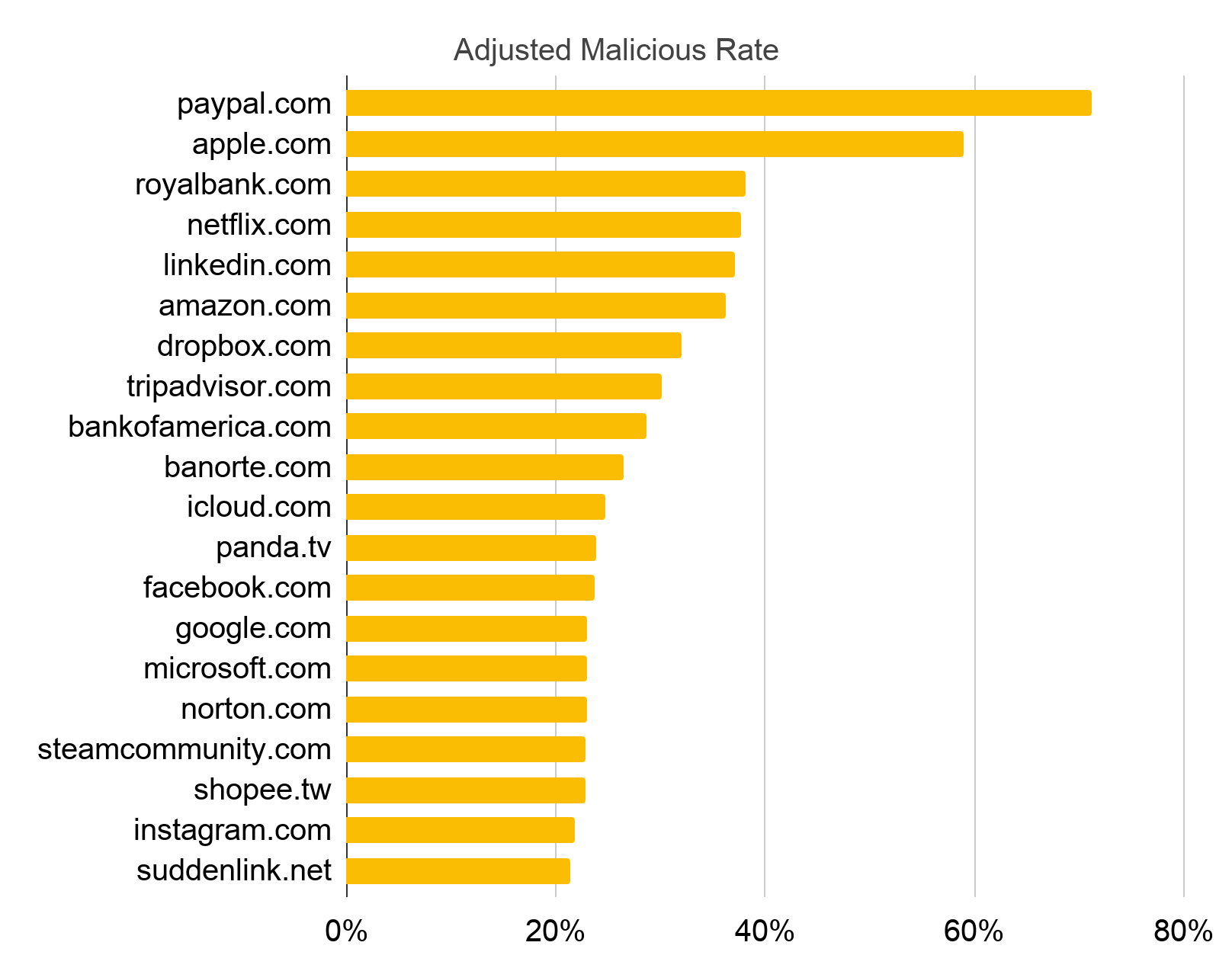
Top 10 Most Abused DNS Services and Autonomous Systems
Next, we look at the DNS services and the autonomous systems (AS) used by squatting domains to understand their infrastructure preferences. An AS is a set of IP subnets maintained by one or more network operators.
The name service used by domain squatters often signifies which registrar was used to register the domain, where the squatting web page is hosted or which parking service these domains utilize to profit from user traffic. Figure 4 displays the most abused name services of squatting domains. Freenom.com and dnspod.com are often used by domain squatters, as they provide cheap or free domain registration and domain hosting. DNSPod is known for hosting shady DNS records and for providing services for malicious bulletproof hosting operators. Level-squatters might choose to use registrar.eu as it supports an unlimited number of subdomains and free URL forwarding, which reduces the cost of deploying and scaling attacks.
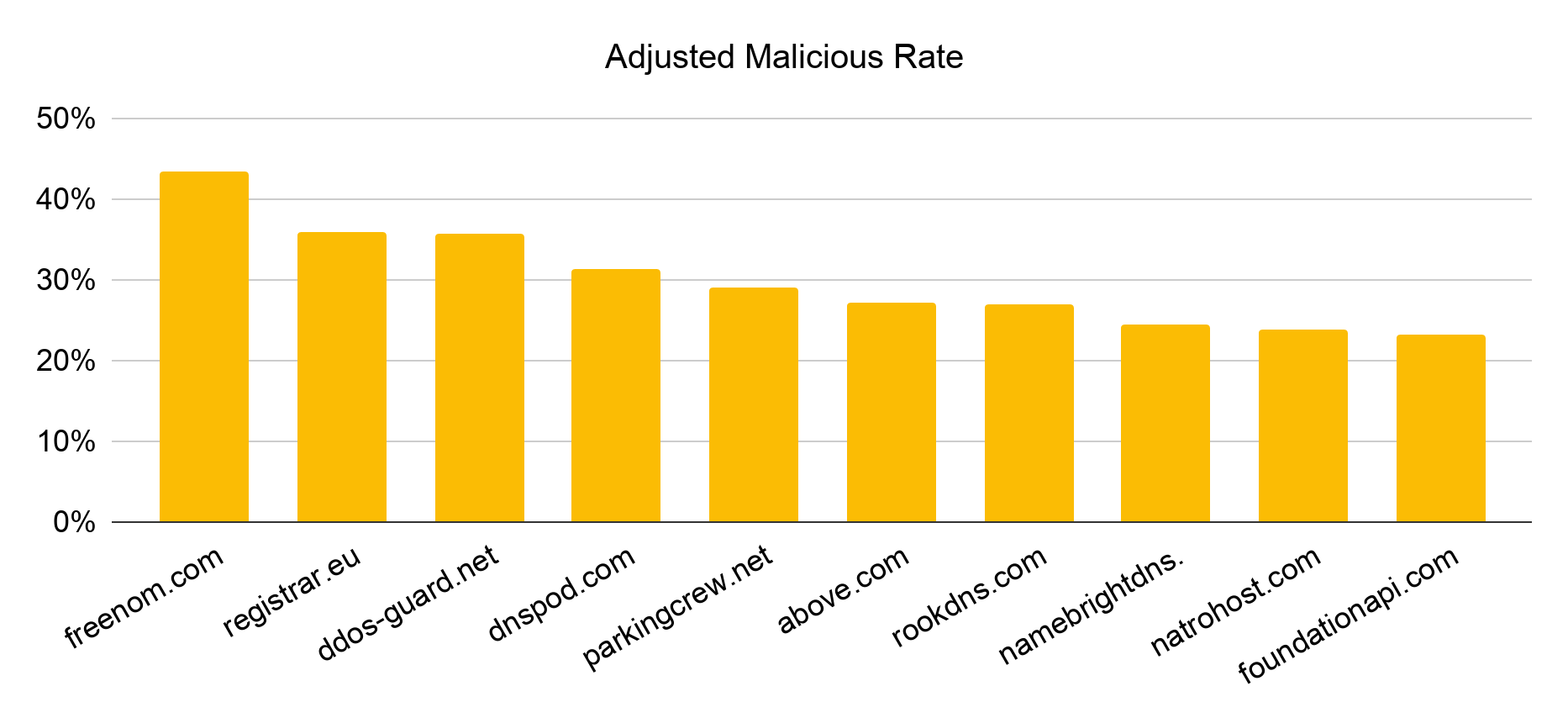
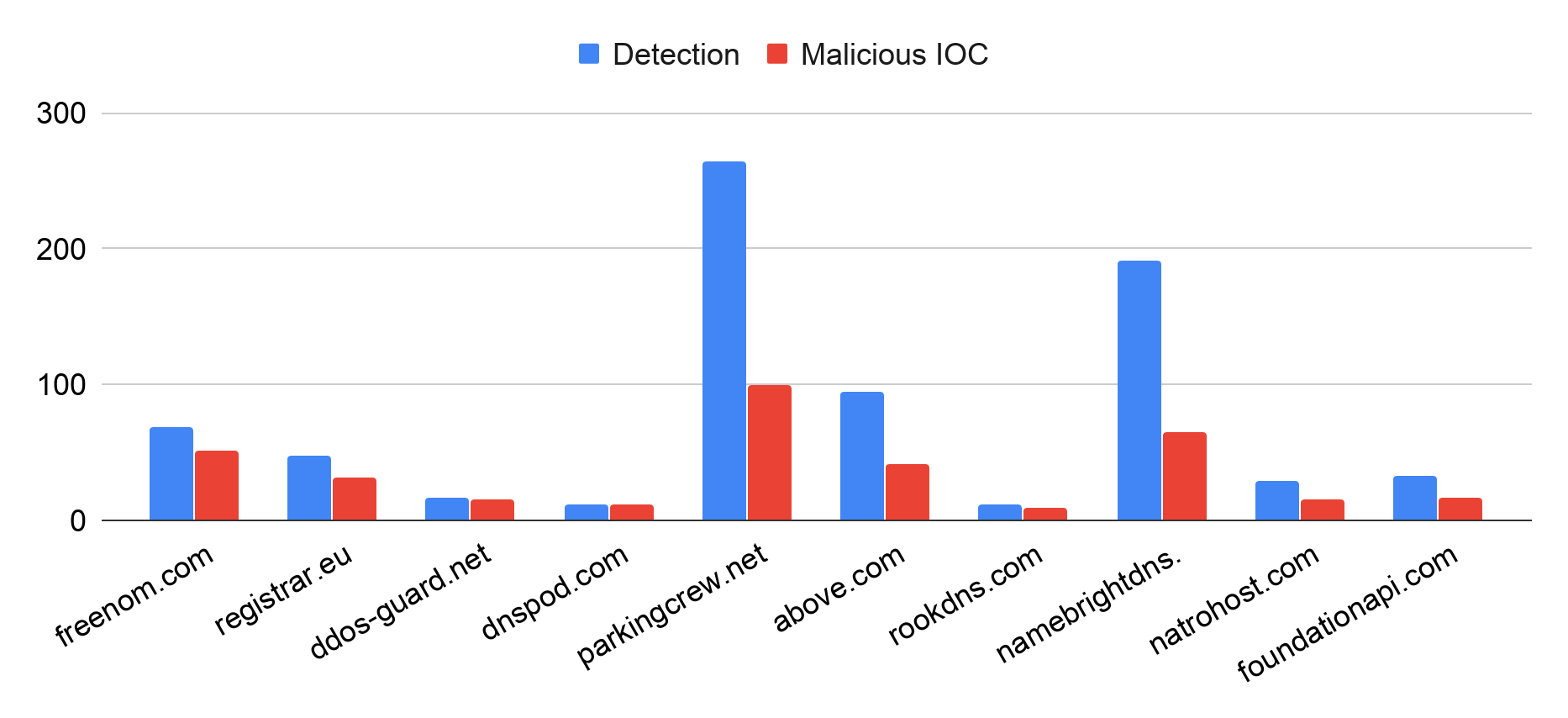
Additionally, parkingcrew.net and above.com are popular parking services because they provide a simple monetization avenue to domain owners, achieved by pointing domain names’ DNS records to their name servers. Parking services usually show users parked pages laden with ads or redirect users to affiliate marketing or malicious websites.
As hosting services often have their own AS, we observed that the AS distribution is somewhat consistent with the name service distribution. The top three most abused AS (19495, 48635, 262254) belong to the three most abused name service providers, respectively (freenom.com, registrar.eu, ddos-guard.net). The fourth most abused AS (40034) is owned by ztomy.com, a service favored for DNS hijacking attacks.
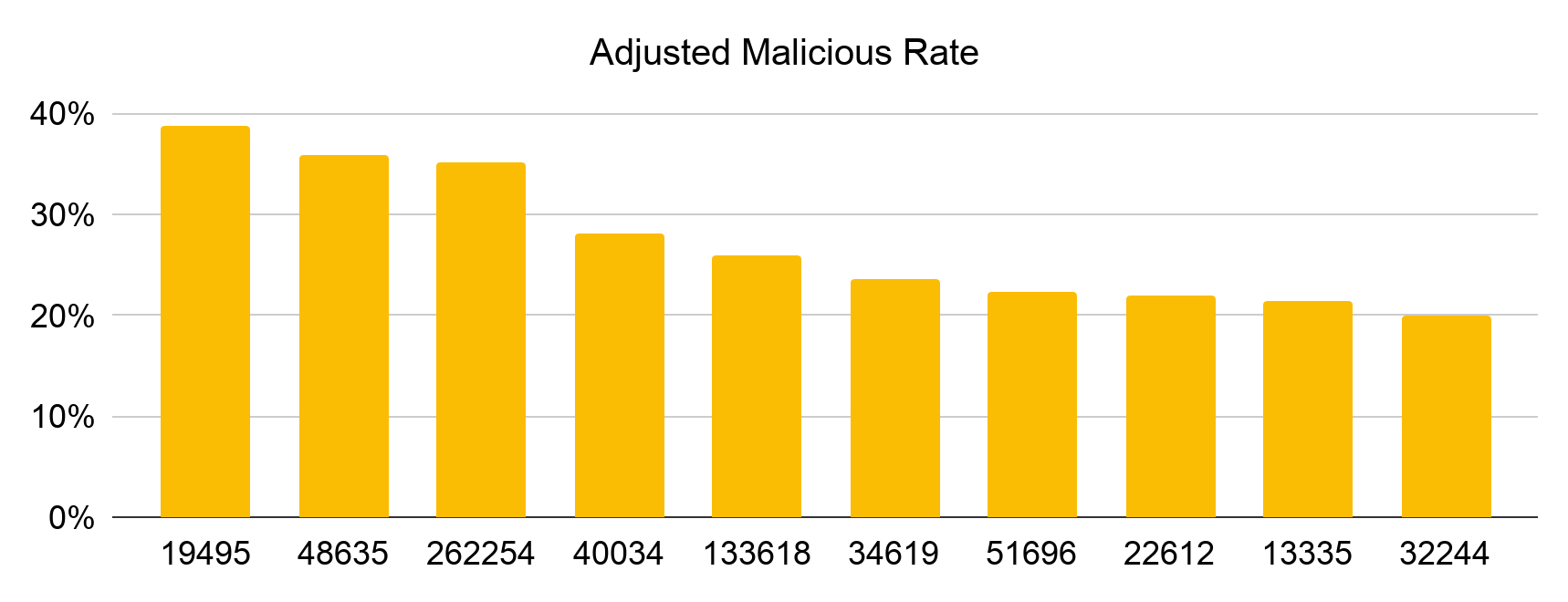
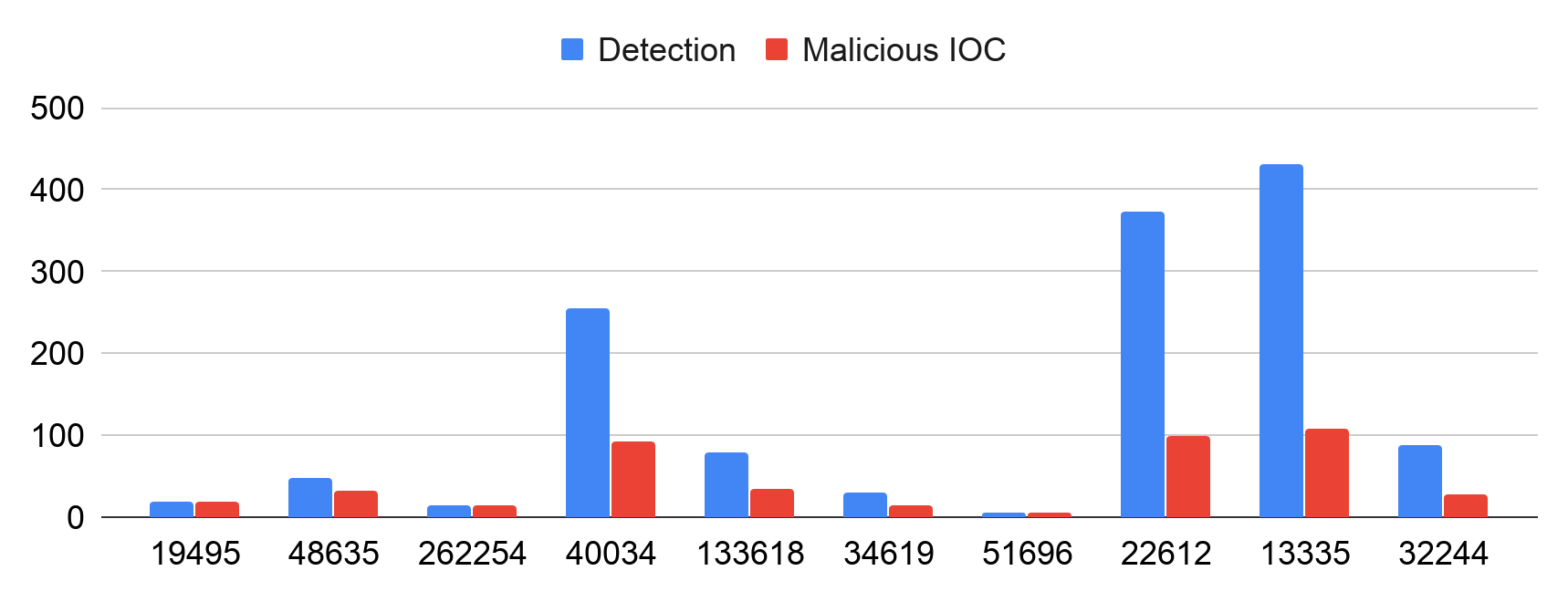
Top 10 Most Abused Registrars
Registrars are entities that sell domain names to users. The most abused registrar, Internet.bs, provides free services preferred by domain squatters, including privacy-protected registration and URL forwarding. We captured several level-squatting campaigns at this registrar. In these campaigns, attackers set up hundreds of subdomains mimicking popular target domains under com-secure-login[.]info and com-finder-me[.]info. An example level-squatting subdomain is www.icloud.com-secure-login[.]info. The second-most abused registrar, Openprovider, offers cheap and easy bulk registrations, attracting many squatting registrations. Additionally, we observed many domains from this registrar having their WHOIS records redacted for privacy. Our system discovered many level-squatting domains registered at TLD Registrar Solutions using the .support TLD (top-level domain), including icloud.com-iphone[.]support and apple.com.recover[.]support, which users might confuse with legitimate Apple technical support services.
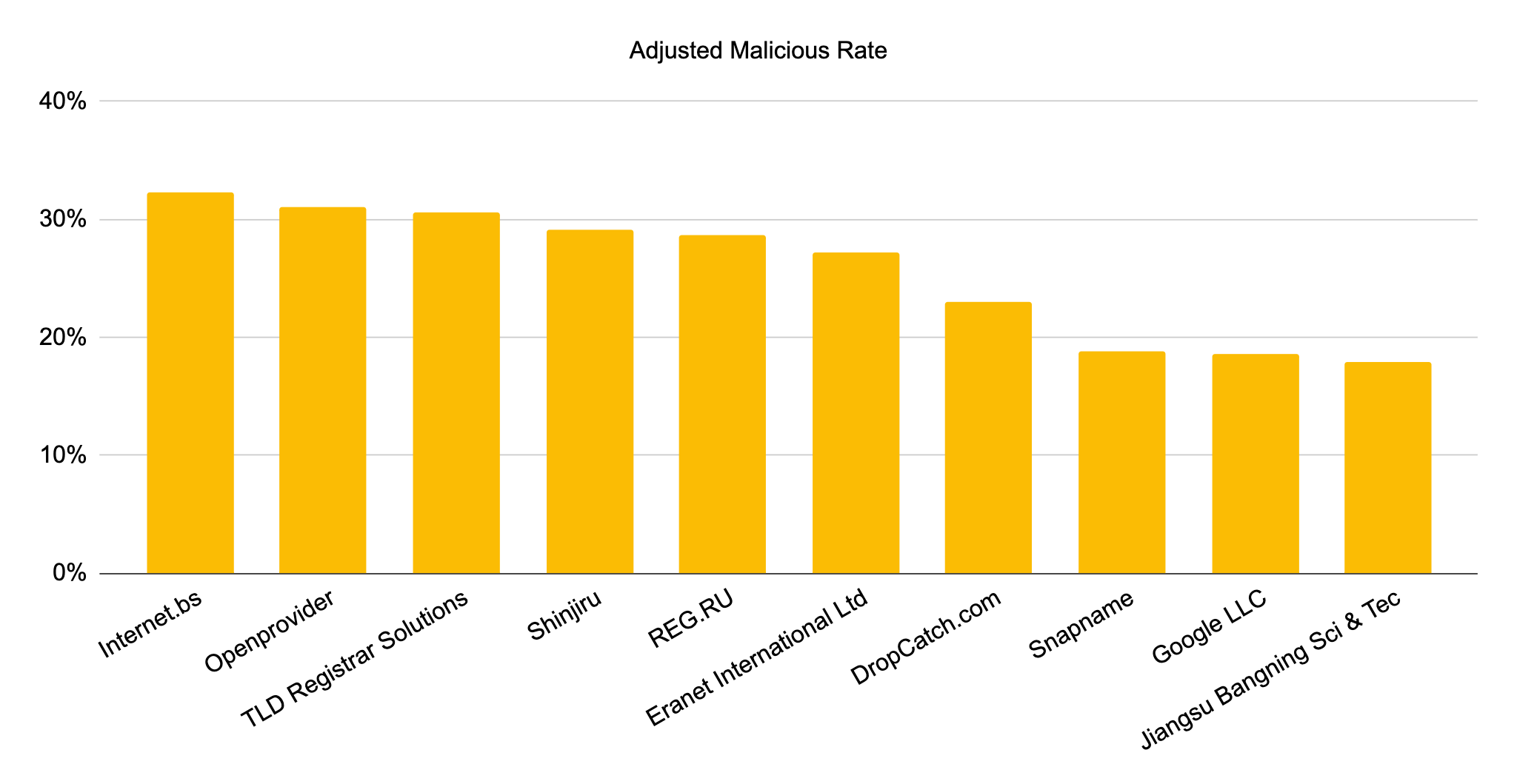
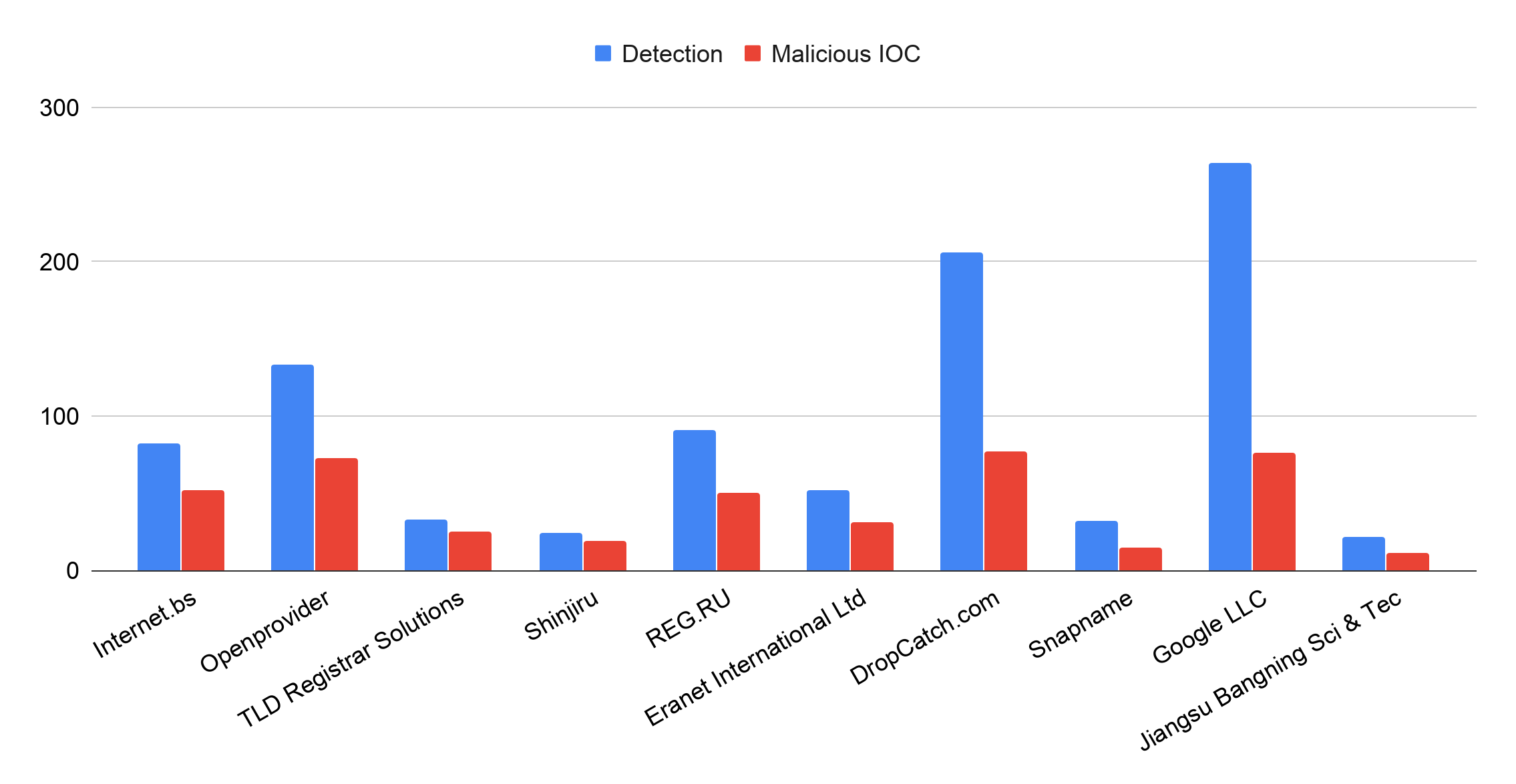
Top 5 Most Abused Certificate Authorities
As HTTPS became common, cybercriminals increased the use of certificates to make their websites appear legitimate. Figure 7 provides an overview of the certificate authorities (CAs) preferred by squatting sites. The most popular CA is Cloudflare, as it offers a bundle, including free SSL encryption. The second most popular CA, cPanel Inc CA, is preferred by domain squatters because of the convenience and the ease of its AutoSSL services. Through cPanel’s management interface, their customers are able to finish all steps of SSL encryption, including certificate purchase, automatic installation and renewal. Thawte CA is not a trusted CA anymore, and browsers will label their certificate as suspicious, but squatting domains are still using it.
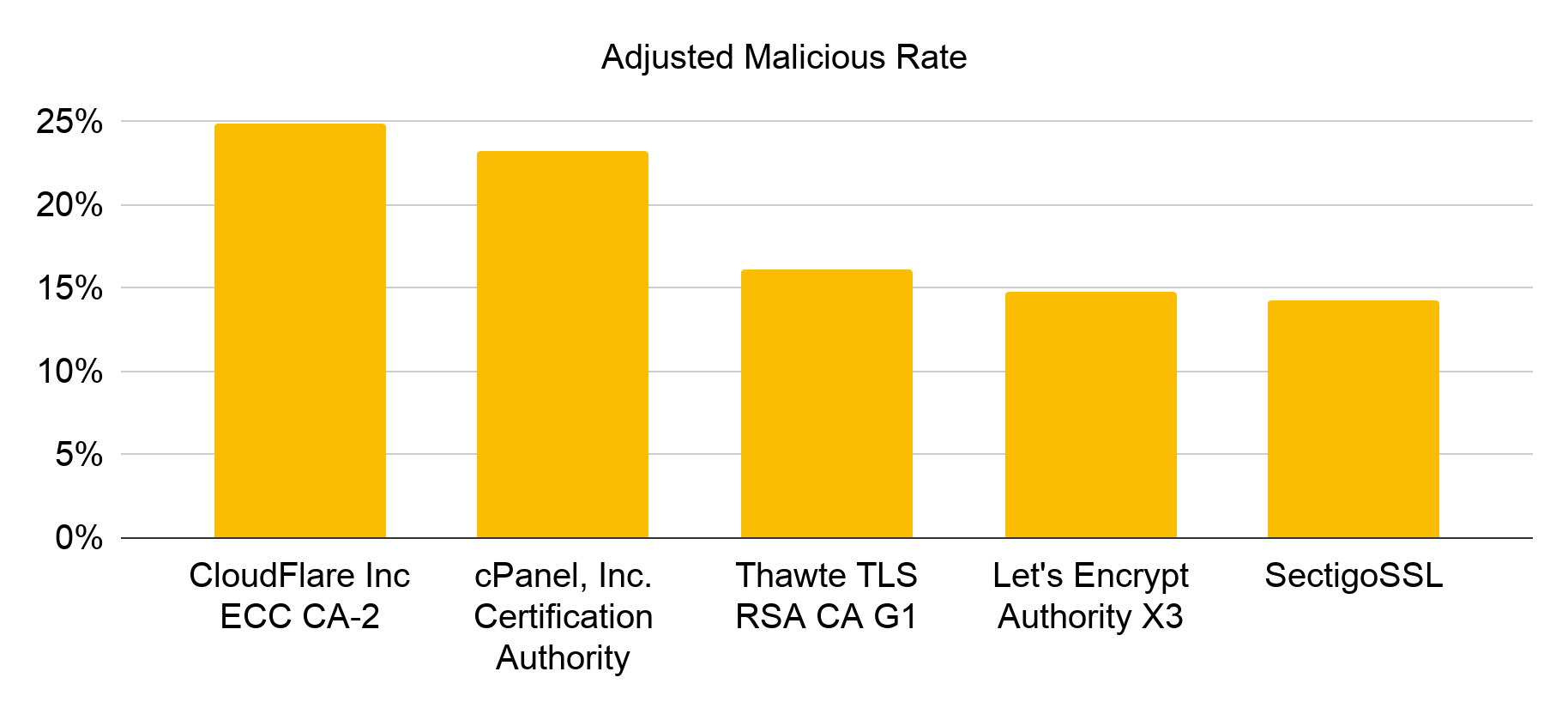
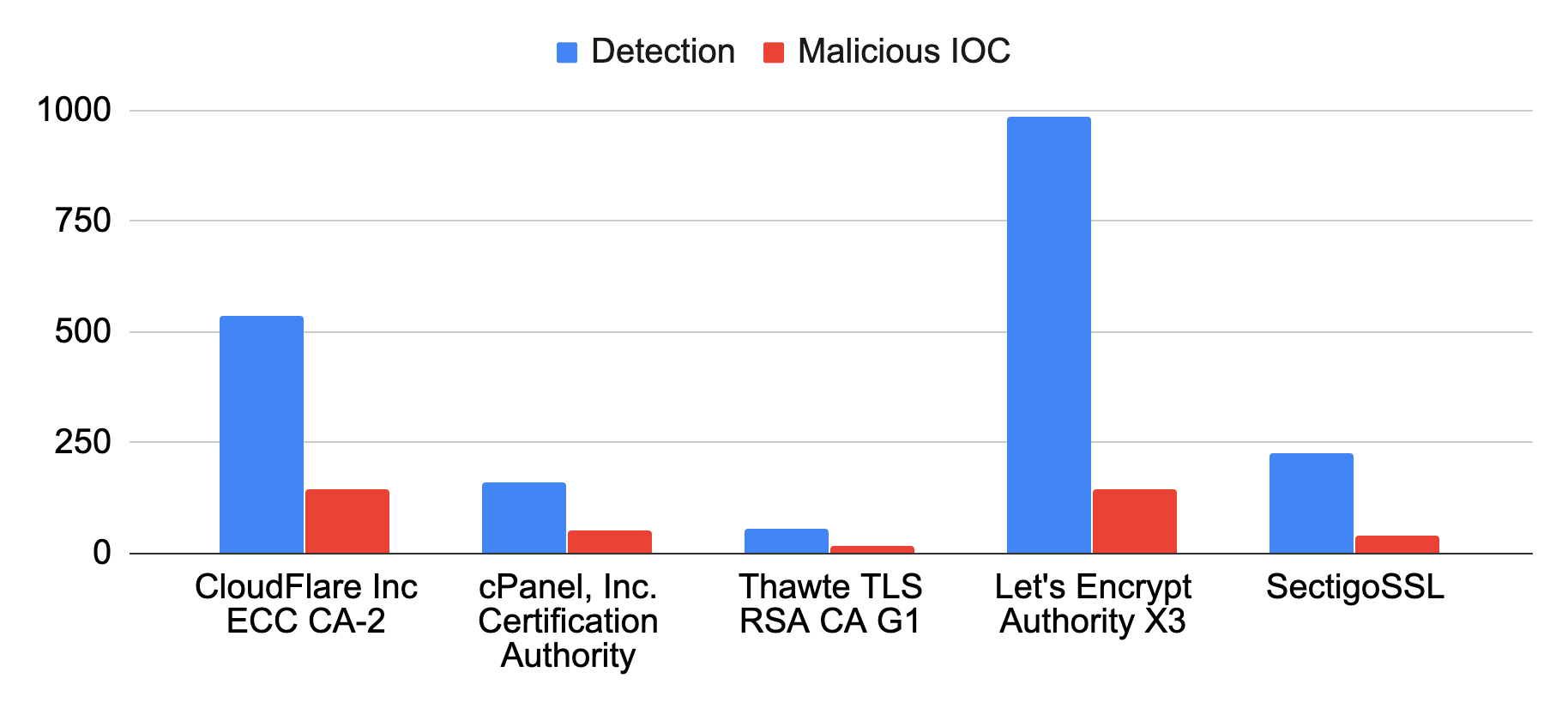
Malicious Usages and Threats
In this section, we discuss in detail different types of abuse leveraging squatting domains. It includes malware distribution, phishing, C2 communication, potentially unwanted programs (PUPs), scams, ad-laden sites and affiliate marketing.
Phishing
Phishing is one of the most popular threats leveraging squatting domains. All of the different squatting techniques we discussed can be used to lure users into believing that a squatting domain is owned by the legitimate brand and to increase the efficiency of phishing and scam campaigns.
One example is a combosquatting domain, secure-wellsfargo[.]org, which targets Wells Fargo’s customers. This domain hosts a copy of Wells Fargo’s official site, as illustrated in Figure 8.a. However, this site is only the front-end portion of the original site, redirecting all clicks to the same login page (shown in Figure 8.b) to steal customers’ sensitive information, including email credentials and ATM PINs.


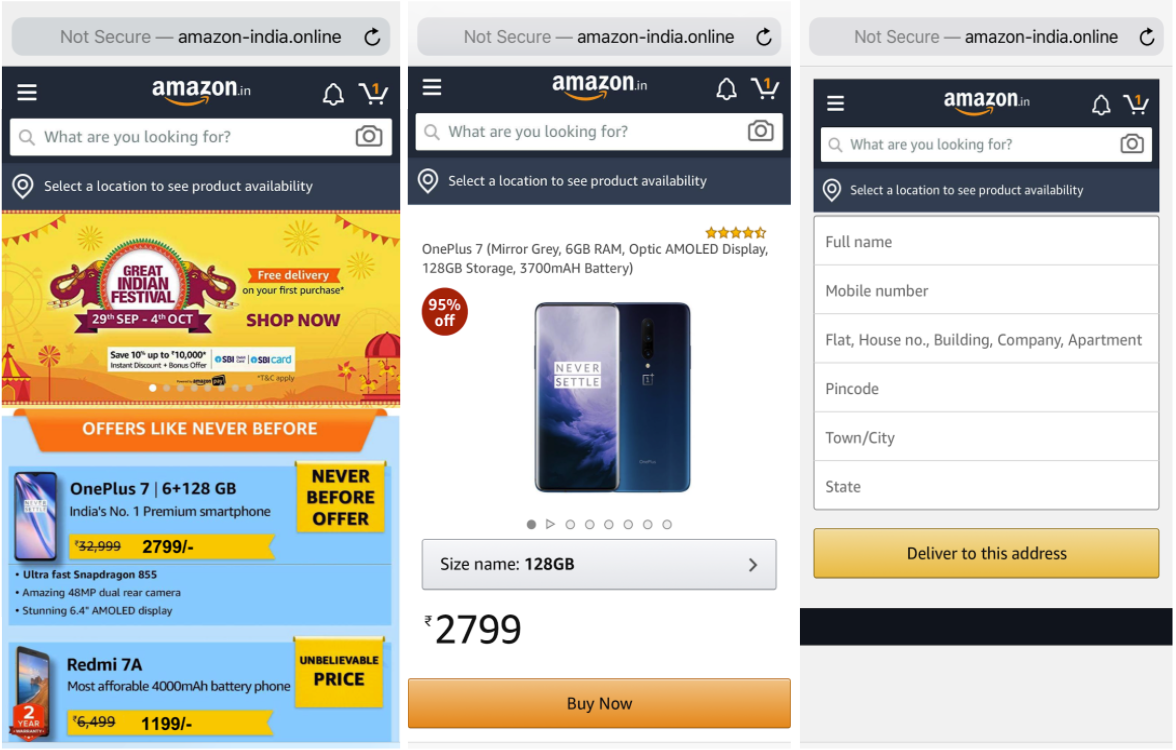
Malware Distribution
Squatting domains are also often used to distribute malware. A combosquatting domain mimicking Samsung (samsungeblyaiphone[.]com) hosts Azorult malware 5acd6d9ac235104f90f9a39c11807c37cdfb103d6c151cc1a2e4e38bf3dbe41f on the URL samsungeblyaiphone[.]com/dolce.exe. Azorult malware is a credential and payment card information stealer, usually spread by phishing emails. It has been an active threat since 2016 and is one of the top malware families. Once the malware executes, it will generate a unique identifier for the compromised machine based on the machine’s globally unique identifier and username. Then the malware will contact the C2 server with this identifier, and it will retrieve the configuration of the infected machine, including the running processes and services. Additionally, Azorult malware often downloads payload from other compromised servers. The new payload can collect and send out sensitive data such as cookies, browser credentials and cryptocurrency information.
Analyzing the malware sample downloaded from samsungeblyaiphone[.]com, we found that it attempted to send a POST request to samsungeblyaiphone[.]com/index.php, which is consistent with this malware family’s known behavior to exfiltrate data. Besides the observed network activity, the malware also displayed suspicious behaviors such as changing the settings of Internet Explorer.
Command & Control (C2)
Malware instances on infected machines typically need to “phone home” to a C2 server for further commands to execute, to download new payloads or to perform data exfiltration. Malware often relies on domain names to locate C2 servers, and these domains are called C2 domains. While using squatting domains for C2 is uncommon, we speculate that the intention of those who do so is to evade automated detection (such as Domain Generation Algorithm detection) and manual analysis.
Our squatting detection system captured squatting domains mimicking Microsoft, microsoft-store-drm-server[.]com on January 30, 2020, and microsoft-sback-server[.]com on February 3, 2020. From the Palo Alto Networks WildFire Malware Analysis Engine, we retrieved similar malware samples, including fa28b59eb0ccd21d3994b0778946679497399b72c2e256ebf2434553cb7bf373 and e7fb436bf7d8784da092315bce1d3511a6055da41fe67362bad7a4c5d3f0294e , connecting to them. These two domain names used the previously mentioned DNSPod for name resolution, which is infamous for being slow in responding to abuse investigations. First, the malware resolved these domains to the same IP address 217.182.227[.]117. Then, it communicated through SSL traffic with the same JA3 (SSL fingerprint): 6312930a139fa3ed22b87abb75c16afa on client-side and 4192c0a946c5bd9b544b4656d9f624a4 on server-side. Observing the same behavior, we conclude they were using the identical SSL application and were part of the same campaign.
Similar to most C2 domains, these two squatting domains were short-lived. They were only used for one to two days after registration and were then abandoned by attackers. Tracking 217.182.227[.]117, we are able to find other C2 domains used by this campaign: store-in-box[.]com from Jan. 27-28, stt-box[.]com from Jan. 29-31, microsoft-store-drm-server[.]com from Jan. 31-Feb. 2, and microsoft-sback-server[.]com on February 3.
Potentially Unwanted Program (PUP)
A PUP could be either standalone software, like spyware or adware, or a browser extension. PUPs usually perform unwanted changes, like changing the browser's default page or hijacking the browser to insert ads. Researchers have shown that some PUP downloaders are also repurposed for malware campaigns. Websites hosting PUPs usually try to scare users by showing them warning messages like “Your computer is infected!” or “Your license has expired!” to convince them to download the advertised software.
Figure 10 shows a combosquatting domain mimicking Walmart (walrmart44[.]com) that distributes PUP. Depending on the browser used, it redirects users to landing pages offering different types of PUPs for download. When we visit this domain in Safari, it tells us that our Flash player might be outdated and offers us the chance to download the newest version from their site, as illustrated in Figure 10.a. While using Chrome, we get a “click continue and install extension” page, as shown in Figure 10.b, which redirects users to the Chrome store for the “Security for Chrome” extension. Alternatively, this website will occasionally redirect users to various legitimate ecommerce websites, including Walmart, Amazon and Aliexpress. After repeated visits, it will remember the source IP address and reject further visits even if we use different browsers (Figure 10.c).

![The screenshot shows how a cybersquatting domain tries to trick users who visit it from a Chrome browser. The popup message reads "Before you continue to walmart44[.]com," and a blue button labeled "continue" is displayed with a green check mark.](https://unit42.paloaltonetworks.com/wp-content/uploads/2020/08/word-image-59.png)

![This screenshot from a cybersquatting domain displays the title "Australlia Scholarship" [sic] and pops up security warnings in the top right corner, including, "PC might be infected!" and "Renew Norton License now."](https://unit42.paloaltonetworks.com/wp-content/uploads/2020/08/word-image-61.png)

Technical Support Scam
Technical support scams are social engineering attacks. An associated website’s purpose is to scare people with audio and visual warnings into believing that their machine is compromised. It prompts people to call the displayed fake technical support center’s phone number. When people call the number, scammers will try to persuade them that the only way to save their machine is by paying for the fraudulent support service. In the case of combosquatting, the domain name often contains keywords like “security,” “alert” and “warning.” An example domain mimicking Microsoft (microsoft-alert[.]club) shown in Figure 12.a was registered on June 11, 2020. This website presents warning messages in Japanese (translated to English in Figure 12.b), renders dynamic content, such as a running command line window, and plays audio alerts.

![This screenshot shows the technical support scam cybersquatting page translated to English. The messages at the top read "Error code 32, Call support [phone number], This computer window is disabled, This computer is infected with the Trojan virus, Your computer warns you that you are infected with porn spyware and viruses."](https://unit42.paloaltonetworks.com/wp-content/uploads/2020/08/word-image-64.png)
Re-bill Scam
Re-bill scammers first offer a subscription to products such as weight loss pills in exchange for a small initial payment. However, if users don’t cancel the subscription after the promotion period, a much higher cost will be charged to their credit cards, usually $50-100. Additional information on this type of scam can be found in Unit 42’s previous research on deceptive affiliate marketing. The combosquatting domain netflixbrazilcovid[.]com leverages both Netflix and the COVID-19 pandemic. The main page looks like the Portuguese Netflix site (Figure 13.a), and has the purpose of obtaining user email addresses. (It is shown translated to English in Figure 13.b.) A deceptive reward message (Figure 13.c) is then shown to potential victims. Finally, users are redirected to a survey and then to a re-bill scam page (Figure 13.d).




Reward Scam
Another popular scam offers users rewards such as free products or money. When we initially captured facebookwinners2020[.]com, it was under development with placeholder images and texts, as shown in Figure 14.a. However, the perpetrators recently replaced placeholders with meaningful content. From the screenshot, we could tell the page mimics a free lottery related to Facebook. To claim the prize, users need to fill out a form with their personal information such as date of birth, phone number, occupation and income (Figure 14.b).


Domain Parking
A common and easy way to monetize user traffic is to use a parking service by pointing the squatting domain’s IP address or NS record to the parking service’s servers. Figure 15 provides an example of a parked domain mimicking RBC Royal Bank, rbyroyalbank[.]com, leveraging a popular parking service, ParkingCrew, to generate profit based on how many users land on the site and click the advertisements. In some cases, parking services also redirect users to scam and phishing pages. As the hostname in the certificate is different from the squatting domain, the browser will label it as “Not secure.” Parked pages usually show users a list of advertisements related to the parked domain. In our example, the ads shown are related to financial services.

Conclusion
In summary, domain squatting techniques leverage the fact that users rely on domain names to identify brands and services on the Internet. These squatting domains are often used for nefarious activities, including phishing, malware and PUP distribution, C2 and various scams. A high rate of malicious and suspicious usage among squatting domains was observed. Therefore, continuous monitoring and analysis of these domains are necessary to protect users.
Palo Alto Networks monitors newly registered domains and newly observed hostnames from pDNS and Zone files to capture emerging squatting campaigns. Our automatic pipeline publishes the domains it detects to URL Filtering and DNS Security using the appropriate category, including malware, phishing, C2 or grayware.
Analyzing the squatting ecosystem, we found that domain squatters prefer certain types of target domains, registrars, hosting services and certificate authorities. The following attributes are common in cases of malicious squatted domains:
- Domain names that are targeting known financial, shopping and banking domains.
- Domains that use frequently abused registrars and hosting services.
- Domains that do not have completely validated SSL certificates.
Therefore, we advise everyone to be more careful when encountering these domains.
Palo Alto Networks customers using URL Filtering, DNS Security, WildFire and Threat Prevention are protected from the threats related to squatting domains mentioned in this blog. Using AutoFocus, our customers can further study the malware mentioned in this blog by using the tag AzoRult.
Acknowledgements
Special thanks to Daiping Liu, Kelvin Kwan, Laura Novak, Jun Javier Wang, Vicky Ray, Eddy Rivera, Erica Naone and Arun Kumar for their help with improving the blog.
IOCs
Sha256
5acd6d9ac235104f90f9a39c11807c37cdfb103d6c151cc1a2e4e38bf3dbe41f
fa28b59eb0ccd21d3994b0778946679497399b72c2e256ebf2434553cb7bf373
e7fb436bf7d8784da092315bce1d3511a6055da41fe67362bad7a4c5d3f0294e
JA3 Pair
Client JA3: 6312930a139fa3ed22b87abb75c16afa
Sever JA3: 4192c0a946c5bd9b544b4656d9f624a4
Malware/Phishing Squatting Hostname
amazon-india[.]online
apple.com.recover[.]support
com-finder-me[.]info
com-secure-login[.]info
facebook.com-account-login-manage.yourfiresale[.]com
icloud.com-iphone[.]support
microsoft-alert[.]club
microsoft-sback-server[.]com
microsoft-store-drm-server[.]com
microsofŧ[.]com (xn--microsof-wyb[.]com)
netflix-payments[.]com
netflixbrazilcovid[.]com
rbyroyalbank[.]com
safety.microsoft.com.mdmfmztwjj.l6kan7uf04p102xmpq[.]bid
samsungeblyaiphone[.]com
samsungpr0mo[.]online
secure-wellsfargo[.]org
store-in-box[.]com
stt-box[.]com
www.icloud.com-secure-login[.]info
Grayware Hostname
4ever21[.]com
facebookwinners2020[.]com
micposoft[.]com
walrmart44[.]com
whatsalpp[.]com
URL
samsungeblyaiphone[.]com/dolce.exe
samsungeblyaiphone[.]com/index.php
IP
217.182.227[.]117
- Anti-cybersquatting Consumer Protection Act (ACPA) (15 USC §1125(d)) ↑












 Get updates from Unit 42
Get updates from Unit 42